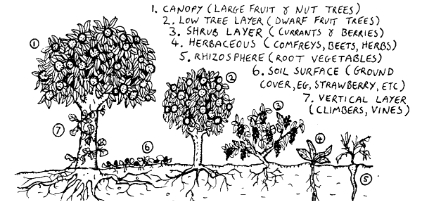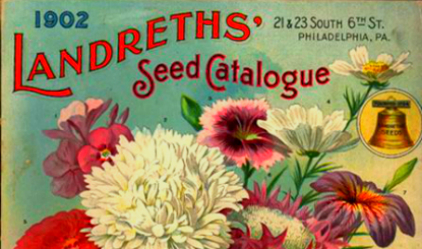
bringing nature, nurseries and gardeners together Jan 3, 2019
Nursery notes: Happy new year! Like many of our plants, it
feels like everyone is still half-dormant at the moment after the
holiday season (and the unpleasant weather of the last few days).
But events are still happening ; - ) The Austin Organic Garden-
ers Club meets on Monday, Jan 14 at 6:30 p.m. at Zilker Botanical
Garden. Joseph Van Dyck will talk about 'Drought Proof Texas,'
and the links between 'photosynthesis and soil fertility' and the
land's ability to hold moisture. - Zilker talk.
Over at the Natural Gardener, staff are hard at work rebuilding
stock. However they are hosting three Organic Veggie 101 classes
on Jan 5, 6, 8, and two Seed Starting and Saving classes on Jan 12
and 15: TNG events. (The nursery is also hiring for the Spring:
apply here.) ❦
____________________________________________________

The forest garden: writer Brian Barth acclaims this approach
as the ultimate organic garden. 'Does a forest need tilling, weed-
ing, fertilizer or irrigation?' he asks. This type of wild gardening,
'standard for millennia in many tropical regions' is now taking off
in more temperate climates, and has been embraced by the perma-
culture movement. Modern Farmer ❦
____________________________________________________
Top new plant discoveries in 2018: from 'spectacular orchids to
towering trees' the Royal Botanical Gardens in the UK reports 128
new plants and 44 new species of fungi - including a climbing
species of yam, an edible 'hedgehog mushroom,' and a new species
of allspice. The Guardian ❦
____________________________________________________
The Austin Garden is sponsored by Hays Free Press

____________________________________________________
Central Texas Gardener: an in-studio chat with Flora Grubb
(Flora Grubb Gardens) from San Francisco, and on-tour a visit to a
small courtyard makeover. Zach Helfin from Thigh High Gardens
in San Marcos demonstrates the tools you need to prune your
trees. Saturday 4 p.m., Sunday 9 a.m. KLRU ❦

January in the Garden
by Chris Winslow
We find ourselves in a month where rapid fluctuations in temp-
erature are the norm. Remember that this is a time of dormancy
for your garden, a time when we must do everything we can to
discourage growth.
Avoid feeding plants, and avoid cutting plants back too soon. For
roses, wait until mid-February. If you have the urge to cut back
perennials such as lantana or firebush to tidy up the yard, be sure
to cut them back above the green wood. Otherwise, with your
clippers, you are sending the plant a message: it's time to start
growing.
What you can do is heap generous amounts of mulch around your
plants to protect the roots for when the cold weather arrives. Some
more things to do this month:
1. Plant a fruit tree. Many fruit tree varieties will arrive in local
nurseries this month, and in February and March. Try apples,
peaches, plums, persimmons, and pears.
2. Prepare spring vegetable garden. I would recommend the sol-
arization method to get rid of weeds. Till your garden with a mech-
anical tiller or a garden spade and water the area thoroughly. Cover
with a clear plastic film and secure the perimeter with rocks or soil.
The sun will raise the temperature in the garden soil to levels that
will kill weeds and seeds. Allow the film to stay on for a month to
six weeks. When removed, your garden will be weed free.
3. Turn off sprinklers. Automatic lawn sprinklers should be set
at a minimum or simply turn them off. (Turf grass is dormant.)
4. Plant a tree. There is still time. Maybe you purchased a living
tree for the holidays. Find that perfect spot, plant it and water it in.
5. Catalog browsing. Find a comfortable armchair, and get to
work! January is a good time to look through garden and seed cat-
alogs to decide on varieties you want to grow this year. Starting a
garden journal is a simple way to keep track of what you plant and
what has been successful.
6. Plant asparagus. Now is the time to prepare beds and plant.
Three year asparagus crowns will arrive in local nurseries early
this month. Beds should be dug deeply and filled with rich org-
anic compost. Three year crowns will put you closer to harvest
than seed grown.
7. Onions are still possible. You still have the opportunity to
produce large onions this year. Also you can plant turnips, collards,
and radishes. Happy gardening everyone! ❦

